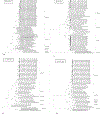Genetic diversity of G9, G3, G8 and G1 rotavirus group A strains circulating among children with acute gastroenteritis in Vietnam from 2016 to 2021
- PMID: 38316245
- PMCID: PMC11299202
- DOI: 10.1016/j.meegid.2024.105566
Genetic diversity of G9, G3, G8 and G1 rotavirus group A strains circulating among children with acute gastroenteritis in Vietnam from 2016 to 2021
Abstract
Rotavirus group A (RVA) is the most common cause of severe childhood diarrhea worldwide. The introduction of rotavirus vaccination programs has contributed to a reduction in hospitalizations and mortality caused by RVA. From 2016 to 2021, we conducted surveillance to monitor RVA prevalence and genotype distribution in Nam Dinh and Thua Thien Hue (TT Hue) provinces where a pilot Rotavin-M1 vaccine (Vietnam) implementation took place from 2017 to 2020. Out of 6626 stool samples, RVA was detected in 2164 (32.6%) by ELISA. RT-PCR using type-specific primers were used to determine the G and P genotypes of RVA-positive specimens. Whole genome sequences of a subset of 52 specimens randomly selected from 2016 to 2021 were mapped using next-generation sequencing. From 2016 to 2021, the G9, G3 and G8 strains dominated, with detected frequencies of 39%, 23%, and 19%, respectively; of which, the most common genotypes identified were G9P[8], G3P[8] and G8P[8]. G1 strains re-emerged in Nam Dinh and TT Hue (29.5% and 11.9%, respectively) from 2020 to 2021. G3 prevalence decreased from 74% to 20% in TT Hue and from 21% to 13% in Nam Dinh province between 2017 and 2021. The G3 strains consisted of 52% human typical G3 (hG3) and 47% equine-like G3 (eG3). Full genome analysis showed substantial diversity among the circulating G3 strains with different backgrounds relating to equine and feline viruses. G9 prevalence decreased sharply from 2016 to 2021 in both provinces. G8 strains peaked during 2019-2020 in Nam Dinh and TT Hue provinces (68% and 46%, respectively). Most G8 and G9 strains had no genetic differences over the surveillance period with very high nucleotide similarities of 99.2-99.9% and 99.1-99.7%, respectively. The G1 strains were not derived from the RVA vaccine. Changes in the genotype distribution and substantial diversity among circulating strains were detected throughout the surveillance period and differed between the two provinces. Determining vaccine effectiveness against circulating strains over time will be important to ensure that observed changes are due to natural secular variation and not from vaccine pressure.
Keywords: Acute gastroenteritis (AGE); Genotype distribution; Rotavin-M1; Rotavirus group A (RVA); Vietnam; Whole genome sequence.
Copyright © 2024. Published by Elsevier B.V.
Conflict of interest statement
Declaration of competing interest The authors declare the following financial interests/personal relationships which may be considered as potential competing interests. The findings and conclusions in this report are those of the authors and do not necessarily represent the official position of the Centers for Disease Control and Prevention – USA. Trang Nguyen reports financial support for this project was provided byBill & Melinda Gates Foundation - USA. If there are other authors, they declare that they have no known competing financial interests or personal relationships that could have appeared to influence the work reported in this paper.
Figures


Similar articles
-
Upsurge and spread of G3 rotaviruses in Eastern India (2014-2016): Full genome analyses reveals heterogeneity within Wa-like genomic constellation.Infect Genet Evol. 2018 Sep;63:158-174. doi: 10.1016/j.meegid.2018.05.026. Epub 2018 May 26. Infect Genet Evol. 2018. PMID: 29842980
-
Increasing predominance of G8P[8] species A rotaviruses in children admitted to hospital with acute gastroenteritis in Thailand, 2010-2013.Arch Virol. 2018 Aug;163(8):2165-2178. doi: 10.1007/s00705-018-3848-0. Epub 2018 Apr 25. Arch Virol. 2018. PMID: 29696408
-
Genomic Constellation of Human Rotavirus G8 Strains in Brazil over a 13-Year Period: Detection of the Novel Bovine-like G8P[8] Strains with the DS-1-like Backbone.Viruses. 2023 Mar 1;15(3):664. doi: 10.3390/v15030664. Viruses. 2023. PMID: 36992373 Free PMC article.
-
Characterization of human rotaviruses circulating in Iraq in 2008: atypical G8 and high prevalence of P[6] strains.Infect Genet Evol. 2013 Jun;16:212-7. doi: 10.1016/j.meegid.2012.12.003. Epub 2013 Jan 20. Infect Genet Evol. 2013. PMID: 23340225
-
Rotavirus Strain Trends in United States, 2009-2016: Results from the National Rotavirus Strain Surveillance System (NRSSS).Viruses. 2022 Aug 15;14(8):1775. doi: 10.3390/v14081775. Viruses. 2022. PMID: 36016397 Free PMC article. Review.
Cited by
-
A report for the fifth International Workshop on Rotavirus and Norovirus in China.Hum Vaccin Immunother. 2025 Dec;21(1):2512647. doi: 10.1080/21645515.2025.2512647. Epub 2025 Jun 9. Hum Vaccin Immunother. 2025. PMID: 40485371 Free PMC article.
-
Genomic analysis of DS-1-like human rotavirus A strains uncovers genetic relatedness of NSP4 gene with animal strains in Manhiça District, Southern Mozambique.Sci Rep. 2024 Dec 28;14(1):30705. doi: 10.1038/s41598-024-79767-4. Sci Rep. 2024. PMID: 39730435 Free PMC article.
-
Mutations in the main antigenic sites of VP7 and VP8* from G3P[8] rotavirus a strains circulating in Brazil may impact immune evasion to rotavirus vaccination.Braz J Microbiol. 2025 Mar;56(1):319-330. doi: 10.1007/s42770-024-01542-4. Epub 2024 Nov 7. Braz J Microbiol. 2025. PMID: 39505807
References
-
- Bonura F, Mangiaracina L, Filizzolo C, Bonura C, Martella V, Ciarlet M, Giammanco GM, De Grazia S, 2022b. Impact of vaccination on rotavirus genotype diversity: A nearly two-decade-long epidemiological study before and after rotavirus vaccine introduction in Sicily, Italy. Pathogens. 11 10.3390/pathogens11040424. - DOI - PMC - PubMed
Publication types
MeSH terms
Substances
Grants and funding
LinkOut - more resources
Full Text Sources
Medical

